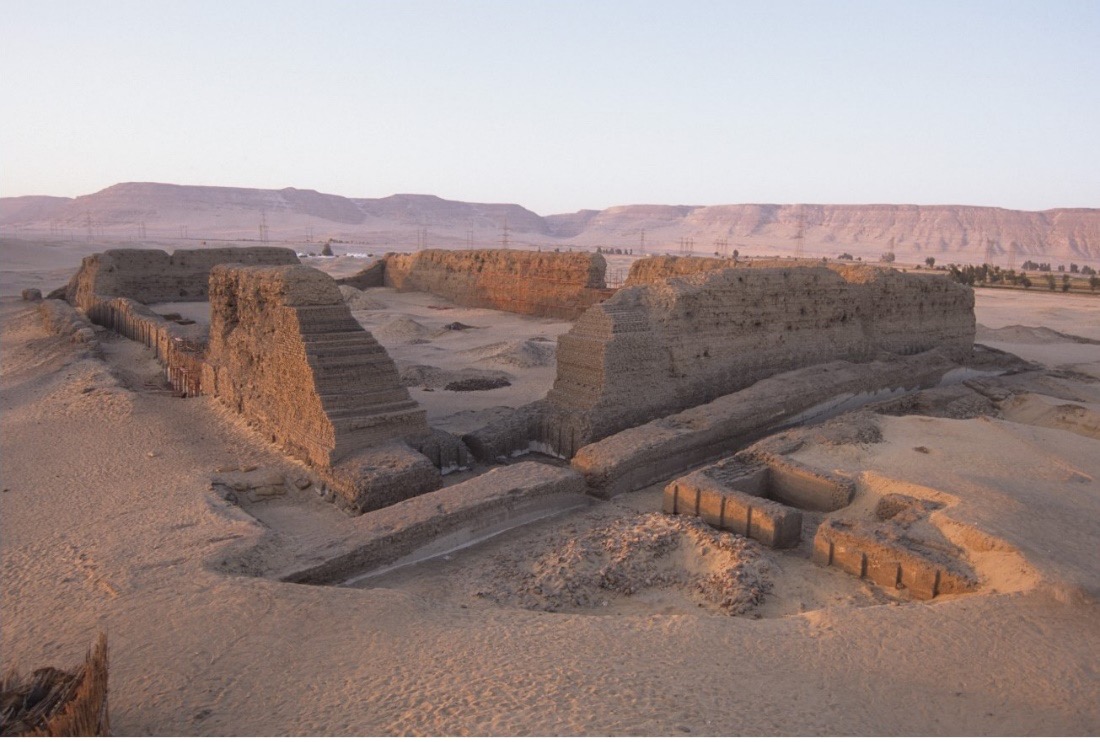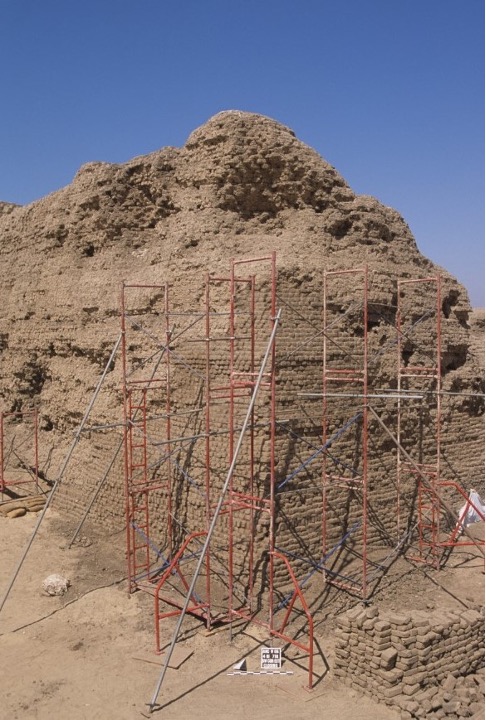- EraEarly Dynastic Period
- Project DirectorDavid O’Connor and Matthew D. Adams
- LocationSohag Governorate
- AffiliationAmerican Research Center in Egypt (ARCE)
- Project SponsorUSAID
Written by: Briana Jackson
The desert landscape of Abydos, an ancient site in southern Egypt, is dominated by a massive rectangular mudbrick enclosure measuring 133.5 by 77.7 meters (or 438 by 255 feet). Today, this monument is called Shunet el-Zebib, which means “storehouse of raisins” for reasons unknown. However, in antiquity, it served as a royal monument for the last king of the Second Dynasty (2890 – c. 2686 BCE), Khasekhemwy, whose reign ended in around 2686 BCE. His tomb was also constructed at the royal cemetery in Abydos at the site now called Umm el-Qaab (“mother of pots”). He had an earlier, smaller enclosure built at Hierakonpolis, another important and sacred site that was dedicated to the god Horus. At Abydos, other enclosures dedicated to kings of the First Dynasty (3100 BCE) and to Peribsen of the Second Dynasty (2890 – c. 2686 BCE) had also been built in the area surrounding Khasekhemwy’s enclosure.
General view of Shunet el Zebib enclosure with adjacent Peribsen enclosure.
Enclosures dating to earlier than the Predynastic Period have not yet been found. Amongst the enclosures of the First Dynasty (approximately 3100 BCE) and Peribsen, only the foundations remain. As revealed by archaeology, the enclosures were dismantled by subsequent royalty, who then had theirs built. Khasekhemwy’s enclosure survived this phenomenon because the site was abandoned by the kings of the Third Dynasty (c. 2686 BCE–c. 2613 BCE) who chose to focus on monumental construction at Saqqara in northern Egypt. Therefore, subsequent kings did not need to dismantle it. Today, his enclosure stands sentry as a reminder of over 3000 years of rich activity at the sacred site of Abydos.
Chamber with deposit of offering pottery in the North gateway area.
The mammoth mudbrick enclosure seems to bind nothing within, but its walls are interrupted on all four sides—the middle of the western wall, somewhat toward the southwest corner, the southeast corner, and the northeast corner—by gateways. Within the enclosure at the southeast gateway, a smaller structure, possibly a chapel, was found. Due to the sacredness of the entire Abydos landscape, and the possible association with the royal tombs at Umm el-Qaab, it is likely the smaller interior building and the enclosure were used for ritual or ceremonial purposes for the living king or for a funerary ritual. Moreover, beer jars and associated boat graves cemented the interpretation that the enclosure was a sacred monument, imbued with funerary meaning. Just as the entire landscape of Abydos is a cemetery for humans and various animal species alike, the Shunet el-Zebib also served as a cemetery for ibis mummies. Beginning in the Third Intermediate Period (c. 1070 – c. 664 BCE), ancient Egyptians buried thousands of ibis mummies in votive jars within the enclosure.
Due to the nature of mudbrick, the damage caused by the passage of thousands of years, erosion from the environment, and birds and hornets that have built their houses in the walls, the enclosure had largely deteriorated. The majority of the damage, however, has been the result of Late Antique activity. During this period, a Coptic monastic community carved cells in the walls of the Shunet el-Zebib to use as living spaces. The monument’s significance is inarguable, not only for understanding the history of Abydos as ancient Egypt’s most sacred site, but also for understanding the religious and royal practices of the earliest kings of Egypt. Therefore, conservation of the monument was paramount.
In 1999, the Shunet el-Zebib conservation project began through a joint mission of the University of Pennsylvania Museum-Yale University-Institute of Fine Arts and the New York University Expedition to North Abydos, Egypt (PYIFA), co-directed by David O’Connor and the late William Kelly Simpson, as well as then-associate director Matthew Douglas Adams (now co-director for excavations at the Abydos north cemetery with Deborah Vischak with the Institute of Fine Arts-New York University/Princeton University North Abydos Expedition joint mission). The conservation project received funding from the Egyptian Antiquities Project between 1999 and 2006 and from the Egyptian Antiquities Conservation Project from 2010 to 2012. Together, these grants allowed the PYIFA mission to complete at least 75% of the conservation of the Shunet el-Zebib.
Stabilization work on the southwest corridor exterior.
The conservation project is not meant to restore the Shunet el-Zebib enclosure, but to stabilize the extant architecture in danger of collapse. Conservation at the western gateway managed to hint at the magnificence of the enclosure as it would have looked during Khasekhemwy’s reign, preserving the plastered and niched façade. Conservation was and continues to be achieved by filling holes and shoring up walls with locally crafted mudbrick which was stamped with the letters PYIFA to distinguish them from the ancient bricks. The application of mudbrick was supervised by expert architectural conservators and consultants William C.S. Remsen, Conor Power, and Anthony Crosby, the latter of whom continues to supervise and consult the ongoing conservation project.
Further conservation is still underway. Most recently, as of 2019, the southeast and northeast gateways have seen considerable progress in conservation efforts. The Shunet el-Zebib is currently open to tourists for visits, accompanied by an informational panel detailing its historical and archaeological significance.


